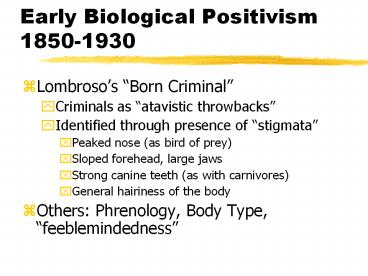Early Biological Positivism 1850-1930 - PowerPoint PPT Presentation
Title:
Early Biological Positivism 1850-1930
Description:
Early Biological Positivism 1850-1930 Lombroso s Born Criminal Criminals as atavistic throwbacks Identified through presence of stigmata – PowerPoint PPT presentation
Number of Views:139
Avg rating:3.0/5.0
Title: Early Biological Positivism 1850-1930
1
Early Biological Positivism1850-1930
- Lombrosos Born Criminal
- Criminals as atavistic throwbacks
- Identified through presence of stigmata
- Peaked nose (as bird of prey)
- Sloped forehead, large jaws
- Strong canine teeth (as with carnivores)
- General hairiness of the body
- Others Phrenology, Body Type, feeblemindedness
2
The XYY supermale
- An extra Y chromosome
- Initial discovery in 1961
- Flurry of activity immediately after
- Not a supermale
- Low intelligence, physiological differences
- More evidence that XXY abnormality related to
crime - Even here, very rare and due to learning disorders
3
The demise of early positivism
- 1. Poor theory
- Single biological trait as direct cause of crime.
- 2. Poor/biased research
- Crime runs in families (Dugdale)
- 3. Dangerous policy implications
- Eugenics movement
- Largely discredited by Sociologists by 1950.
4
Where does biology stand now?
- Impression from the Barkan book?
- Criticizes all biological research on poor
methodology or shifting definitions of crime - Example, Barkan Why dont all aggressive or
risk-seeking people commit crimes? - Football players, sky-divers
- Response But, why dont most people who face
poverty and inequality commit crime? - Get a job at MacDonalds, muddle through life
5
Is Criminality Inherited?
- KEY IS SEPARATING NATURE AND NURTURE
- Parental Deviance (Crime runs in family)
- Twin Studies
- Adoption Studies
6
Parental Deviance
- Parents crime and deviance is a robust predictor
of the childs delinquency - Due to genetics, or other factors?
- Deviant parents more likely to use harsh/erratic
discipline, less supervision? - Deviant parents live in bad neighborhoods?
- Deviant parents abuse children/each other?
7
Twin Studies
- Compare MZ twins with DZ twins
- Concordance rates if one twin is criminal, is
the other? - Danish Study (Christiansen, 1979)
- MZ52
- DZ22
8
Adoption Studies
- Compare the two sets of parents that an adopted
youth has. - Biological parents?genetics
- Adoptive parents?social circumstance
9
Cross Fostering AnalysisMednick et al. (1984)
CRITICISMS OF THIS?
10
Biology is not necessarily dependent on genetics
- Prenatal or Perinatal harms
- Maternal smoking, drinking, drug use
- Low birth weight, premature, delivery
complications - Environmental Influences
- Diet (excessive sugar, etc)
- Exposure to toxins (e.g., lead)
- Physical harm (head trauma, etc)
11
What biological mechanisms are inherited or
damaged?
- Neurological Functioning
- PET scans, EEG readings
- Indirect measures (IQ, Impulsivity tests)
- Central Nervous System (CNS) or Anatomic Nervous
System (ANS) - Heart rate
- Skin Conductance
12
HOW might biology effect behavior?
- Direct Effects (less common)
- Head trauma?personality (Phinneas Gauge, Charles
Whitman) - Diet Excessive Sugar? Hyperactivity
- Indirect Effects
- Less responsive nervous system? response to pain
? hard to condition - Maternal Smoking during pregnancy ?
impulsivity/low IQ ? school failure ? delinquency
13
Terrie Moffits Biosocial Theory
- Biology
- Some children have slight neurophysiological
deficits - Causes of NPD? Perinatal harm, genetic
- Results of NPD? Difficult temperament, Slow to
learn, difficult to parent, impulsive - Environments
- Some parents are poorly equipped to handle such a
child - Lack of resources, lack of parenting skills
14
Biosocial Explanation of Female Delinquency
- Caspi et al. (1993)
- Biology
- Early sexual maturation in females
- Measure age at first period
- Environment
- Exposure to crime prone associates
- Measure type of school (mixed gender or not)
15
Policy Implications
- Old Biology
- Eugenics
- New Biosocial
- Social factors can be changed, biology can
identify at-risk children - Some biological factors can be changed
- Drugs
- Reduce prenatal risk to fetus
16
Barkans Critique of Biology and Crime
- The relativity of deviance
- Methodological problems
- Inadequate control, small sample sizes, etc
- Group rate differences
- Social/policy implications
- Cant change biology?
17
SUMMARY OF BIOLOGY
- All modern biological theories incorporate
sociological or psychological concepts. - Biology related in an indirect fashion--and with
the environment. - Caspis research on female criminality
- Moffitts biosocial theory































